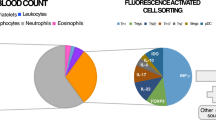Abstract
Achalasia is a neuromuscular disorder of the esophagus with unknown etiology. There have been suggestions that this disorder is immunologically mediated. To examine this possibility, HLA phenotyping was prospectively performed on 40 patients with documented achalasia (24 Caucasian, 16 blacks). Results showed a positive association for the class II HLA antigen, DQwl, with 83% of Caucasians (P <0.02) and 86% of blacks having the antigen (NS). The relative risk for developing achalasia with the presence of DQw1 was 4.2 in Caucasians and 3.6 in blacks. A negative correlation for the DRw53 antigen was noted in Caucasian patients with a relative risk of 0.23. These results indicate an immunogenetic association for achalasia and provide insight into the pathogenesis of this disorder.
Similar content being viewed by others
References
Cohen S, Lipshutz W: Lower esophageal sphincter dysfunction in achalasia. Gastroenterology 61:814–820, 1972
Cassella R, Brown A, Sayre G, Ellis F: Achalasia of the esophagus: Pathologic and etiologic considerations. Ann Surg 1960:474–486, 1964
Cassella R, Ellis F, Brown A: Fine structure changes in achalasia of the esophagus. I. Vagus Nerve. Am J Pathol 46:279–288, 1965
Simila S, Kokkonen J, Kaski M: Achalasia Sicca-juvenile Sjogren's syndrome with achalasia and gastric hyposecretion. Eur J Pediatr 129:175–181, 1978
Weissmann G: Sjogren's syndrome. Review of the literature and report of a case with achalasia of the esophagus. Am J Med 24:475–481, 1958
Smith B: The neurological lesion in achalasia of the cardia. Gut 11:388–391, 1970
Misiewicz JJ, Waller SL, Anthony PP, Gummer JWP: Achalasia of the cardia: Pharmacology and histopathology of isolated cardiac sphincteric muscle from patients with and without achalasia. Q J Med 38(149): 17–30, 1969
London FA, Raab DE, Fuller J, Olsen AM: Achalasia in three siblings: A rare occurrence. Mayo Clin Proc 52:97–100, 1977
Nagles RW, Schwartz RD, Stahl WM Jr, Spiro HM: Achalasia in fraternal twins. Ann Intern Med 59:906–910, 1963
Mackler D, Schneider R: Achalasia in father and son. Am J Dig Dis 23(11): 1042–1045, 1978
Kilpatrick ZM, Miller SS: Achalasia in mother and daughter. Gastroenterology 62:1042–1046, 1972
Westley CR, Hervst JJ, Goldman S, Wiser WC: Infantile achalasia: Inherited as an autosomal recessive disorder. J Pediatr 87:243–246, 1975
Singh H, Gupta HL, Sethi RS, Khetartal SK: Cardiac achalasia in childhood. Postgrad Med J 45:327–335, 1969
Rozycki DL, Ruben RJ, Rapin I, Spiro AJ: Autosomal recessive deafness associated with short stature, vitiligo, muscle wasting and achalasia. Arch Otoloaryngol 93:194–197, 1971
Sullivan KA, Amos BD: The HLA system and its detection.In Manual of Clinical Laboratory Immunology, 3rd ed. NR Rose, H Freidman, JL Fahey (eds). Washington, D.C., American Society for Microbiology, 1986, pp. 835–846.
Terasaki PI: Histocompatibility Testing 1980. UCLA Tissue Typing Laboratory, Los Angeles, CA, 1980
Svejgaard A: HLA and disease.In Manual of Clinical Laboratory Immunology, 3rd Ed. NR Rose, H Freidman, JL Fahey (eds). Washington, D.C., American Society for Microbiology, 1986, pp. 912–920
Woolf B: On estimating the relation between blood group and disease. Ann Hum Genet 19:251–253, 1955
Tosi R, Vismara D, Tanigaki N, Ferrara GB, Cicimarra F, Buffolano W, Folio D, Auricchio S: Evidence that celiac disease is primarily associated with aDC locus allelic specificity. Clin Immunol Immunopathol 28:395–404, 1983
Moens H, Fand NR: Hashimoto's thyroiditis is associated with HLA-DRw3. N Engl J Med 229:133, 1987
Fye KH, Terasaki PI, Michalski JP, Daniels TE, Opelz G, Talal N: Relationship of HLA-DW3 and HLA-B8 to Sjogrens syndrome. Arthritis Rheum 21:337–342, 1978
Vadheim CM, Rotter JI, Maclaren NK, Riley WJ, Andersen CE: Preferential transmission of diabetic alleles within theHLA gene complex. N Engl J Med 315:1314–1318, 1986
Bottazzo GF, Pujol-Borrell R, Hanafusa T, Feldman M: Role of aberrant HLA-DR expression and antigen presentation in induction of endocrine autoimmunity. Lancet:1115–1118, 1983
Rosa J, Fellous M: The effect of gamma-interferon on MHC antigens. Immunol Today 5(9):261–262, 1984
Doniach D, Bottazzo GF: Early detection of autoimmune endocrine disorders. Hosp Up-Date 9:1145–1159, 1923
Author information
Authors and Affiliations
Additional information
This protocol (WR-1435) was approved by the WRAMC Human Use Committee/Institutional Review Board and supported by Department of Clinical Investigation funding.
Rights and permissions
About this article
Cite this article
Wong, R.K.H., Maydonovitch, C.L., Metz, S.J. et al. Significant DQw1 association in achalasia. Digest Dis Sci 34, 349–352 (1989). https://doi.org/10.1007/BF01536254
Received:
Revised:
Accepted:
Issue Date:
DOI: https://doi.org/10.1007/BF01536254




